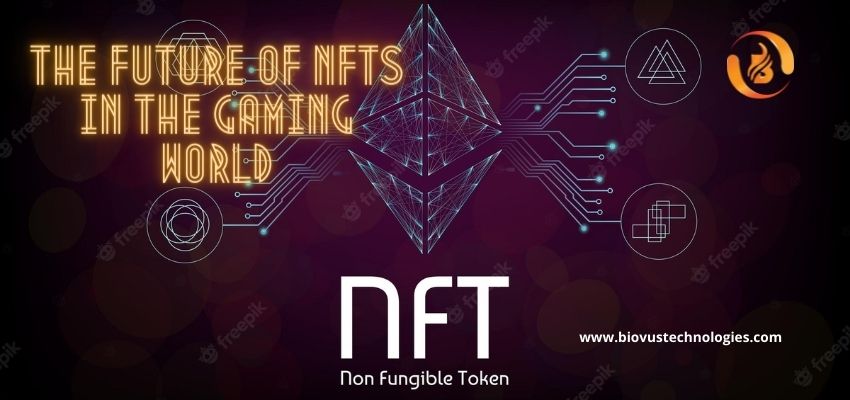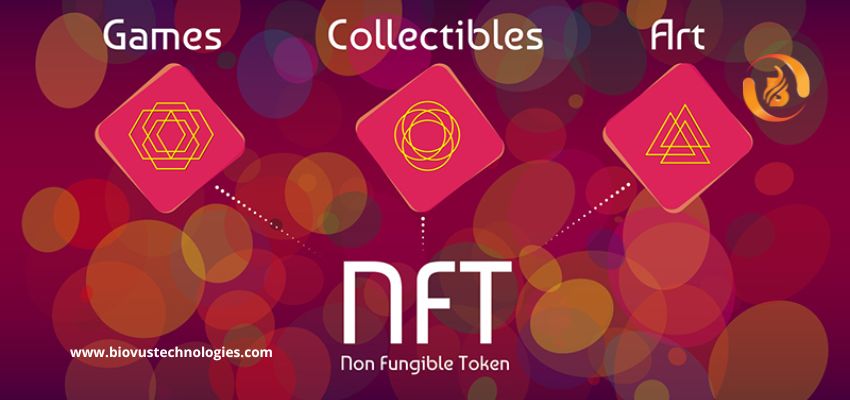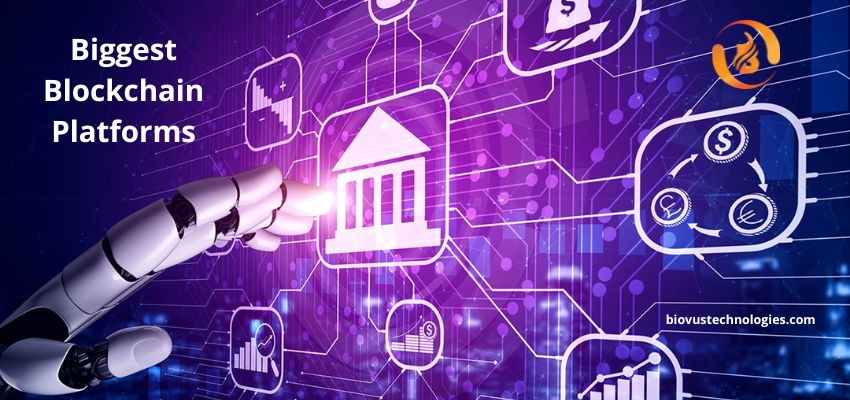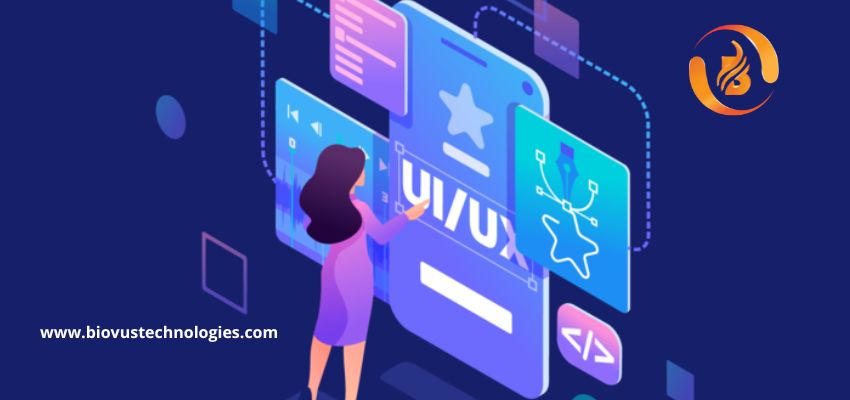What are NFTs?
“Non-fungible token” is what NFT stands for. Simply said, an NFT is an electronic token with a distinct serial number that cannot be divided. As long as two NFTs have different serial numbers, they remain unique even if they tokenize the exact item (for example, the same gif). A digital asset known as an NFT represents a real-world item, such as artwork, music, in-game items, or films. They are regularly purchased and traded online in exchange for cryptocurrencies, and they are typically encoded using the same software as many other cryptos. The future of NFT in the gaming world is increasing rapidly. The NFT gaming sector is expanding and looks set to transform how we perceive and engage with games in the future.
How does NFT Works?
Blockchain, a distributed public ledger that stores transactions, is where NFTs are found. You are most likely familiar with blockchain software as the mechanism underlying cryptocurrencies. Digital things that represent both tangible and ethereal objects are “minted” into an NFT, such as:
- GIFs
- Music
- Designer sneakers
- Art
- Videos and Sports highlights
NFTs are essentially digital versions of actual treasures. So the purchaser receives a digital file rather than an actual oil painting to display on the wall. Additionally, they receive sole ownership rights. Yes, NFTs can only have one owner at a time. Due to the distinctive data of NFTs, it is simple to confirm ownership and transfer tokens between owners. Additionally, the author or owner may choose to store particular data inside them. As an illustration, artists can sign their work by putting their signature in the metadata of an NFT.
What is the future of NFT in the gaming world?
It is not surprising that NFT gaming is expanding quickly because it connects two industries that significantly rely on digital asset collecting. NFT sales, or non-fungible tokens, reached $37 billion by the first week of May, vs $40 billion for the entire year 2021. By the end of 2022, overall NFT sales might treble to $90 billion if they maintain their median weekly total from January.
The Rise of Play-to-Earn
In an exciting play-to-earn environment of in-game tokenomics and gaming NFTs, NFTs and GameFi (Gaming Finance) come together as the next big thing in blockchain gaming. GameFi’s decentralization offers benefits that regular games do not. NFTs can be used to make in-game items more distinctive and valuable, which will lead to an increase in play-to-earn games.
Advantages of the future NFT games
Ownership
In-game purchases and assets are not transferable in conventional gaming. Players who invest money and time in one game find that their hard-earned assets are trapped there, only to lose value when they switch to another game or if the original game’s developers weaken it. Gaming NFTs distribute ownership to the players while giving assets value outside of the gaming industry. An NFT’s ownership status is tracked on the blockchain, and it can be purchased and sold on external markets as a collectible. Many people believe that the NFT gaming market will decentralize the sector and build a player-owned ecosystem.
Liquidity
With traditional games, each game runs on a unique platform developed by various businesses. Since gaming NFTs are tied to the underlying blockchain on which they are based, they may be traded and transferred to other players and buyers. The value of those on various blockchains is represented by their respective tokens, which can be exchanged for cash.
Legitimacy
The immutable records of the blockchain can be used to demonstrate the legitimacy of gaming NFTs. Since uniqueness and scarcity are essential to an asset’s value, authenticity is critical for gaming assets. With blockchain technology, gaming assets cannot be tampered with or copied upon issuance. Players want to be confident that their purchases are genuine because the prices of some virtual goods can reach the tens of thousands or even the millions.

What actually the future NFT gamers looking for?
More Refined Game Mechanism
In this stage of video game development, monetization has taken precedence over game fundamentals. So it comes as no surprise that not everyone has jumped on the NFT bandwagon just yet. Many play-to-earn models don’t involve strategic gameplay and instead focus solely on farming or collecting resources. Beyond merely amassing a collection of monsters, gamers seek more sources of inspiration.
For interactive games, the high gas rates and transaction costs on the blockchain make every action incredibly expensive. True gameplay just does not function with low throughput of 13–15 transactions per second, which prevents games from scaling.
More access to in-game goods
Although selling in-game assets like skins or weapons is an option thanks to NFTs, many players demand greater liquidity. They desire the option of using weaponry in between games. For instance, even if a company discontinued a game, the character, gun, or other items could still be used in the follow-up. For game makers, though, that would be a logistical headache.
Some NFTs employ smart contracts to store metadata, such as character stats that can be updated or to allow users to run different commands. Some game creators are making an effort to implement this. However, it is very expensive and challenging to update, patch, and correct flaws in an NFT.
The Potential for Gaming Design
NFTs could signify a change in the philosophy guiding game design. Some game developers are starting to realize how future NFT could change the way we approach game design. It might encourage designers of video games to adopt a new standard and create objects that work in several games.
Currently, many companies work to combine entertaining gaming with the benefits of game asset ownership that NFTs can offer. With the help of their unique APIs, developers can create games quickly and creatively, pushing the boundaries of gaming. Their NFT marketplace also provides connectivity to other marketplaces to increase liquidity and awareness for NFTs. It serves as a blueprint for the direction Web3 gaming will take in the future.
End Note
In a similar way to how other blockchain technologies have transformed other industries, NFT gaming is in some ways revolutionizing the gaming sector. What cryptocurrencies did for finance, NFTs do for video games. They change the conventional model, where most of the benefits are from an individual engaging in their system. It is gained by powerful centralized institutions, to one where the individual is empowered and compensated more equally.
The future of gaming is NFTs. Why would someone select a game that costs them money instead of making them money? Once the user experience and gameplay of NFT games can genuinely rival immersive games like Fortnite, World of Warcraft, and Grand Theft Auto? Future NFT games will provide a number of micro-economies where players can make money while enjoying their favorite games. It’s every gamer’s fantasy and depends on your country’s cost of living. It might be a full-time job, a side business, or something akin to winning the jackpot.
visit us on: www.biovustechnologies.com








Comment on “What Is NFT And The Future Of NFTs In The Gaming World?”